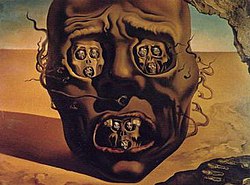The Face of War
| The Face of War (aka The Visage of War) | |
|---|---|
 | |
| Artist | Salvador Dalí |
| Year | 1940 |
| Medium | oil on canvas |
| Dimensions | 64 cm × 79 cm (25.2 in × 31.1 in) |
| Location | Museum Boijmans Van Beuningen, Rotterdam Te Papa Tongarewa, Wellington (temporary) |
The Face of War (The Visage of War; in Spanish La Cara de la Guerra) (1940) is a painting by the Spanish surrealist Salvador Dalí. It was painted during a brief period when the artist lived in California.
The trauma and the view of war had often served as inspiration for Dalí's work. He sometimes believed his artistic vision to be premonitions of war. This work was painted between the end of the Spanish Civil War and the beginning of the Second World War.
The painting depicts a disembodied face hovering against a barren desert landscape. The face is withered like that of a corpse and wears an expression of misery. In its mouth and eye sockets, there are identical faces. In their mouths and eyes, there are more identical faces in a process implied to be infinite. Swarming around the large face are biting serpents. In the lower right corner is a handprint that Dalí insisted was left by his own hand.
The painting is owned by the Museum Boijmans Van Beuningen, in Rotterdam, but is currently on loan to Te Papa Tongarewa in Wellington until November 2021.[1]
References[]
- ^ "Surrealist Art: Masterpieces from Museum Boijmans Van Beuningen". Museum of New Zealand Te Papa Tongarewa, Wellington, NZ. 2020-02-26. Retrieved 2021-07-20.
Sources[]
- 1940 paintings
- Paintings in the collection of the Museum Boijmans Van Beuningen
- Paintings by Salvador Dalí
- Paintings about death
- Anti-war paintings
- Surrealist paintings
- 20th-century painting stubs